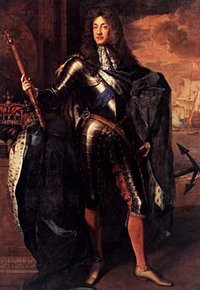James II of England and William of Orange


The Glorious Revolution was the overthrow of James II of England in 1688 by a union of Parliamentarians and the Dutch stadtholder William III of Orange-Nassau (William of Orange).
James II of England and William of Orange


It is sometimes called the Bloodless Revolution, although there was plenty of fighting and loss of life in Ireland and Scotland; many modern historians prefer the more neutral alternative Revolution of 1688. The Revolution is closely tied in with the events of the Nine Years War on the continent of Europe, and may be seen as the last successful invasion of England. It can also be argued that James' overthrow began modern English parliamentary democracy; never again would the monarch hold absolute power.
James's greatest political problem was his Catholicism,
which left him alienated from both parties in Parliament. When James inherited
the throne in 1685, he had much support in the 'Loyal Parliament', which was
composed mostly of Tories (High Church Anglicans). James's attempt to relax the
penal laws alienated his natural supporters, however, because the Tories viewed
this as
tantamount to
disestablishment of the Church of England.
James also created a large standing army and employed Catholics in positions of
power in the army. To his opponents in Parliament this seemed like a prelude to
arbitrary rule, so James prorogued Parliament
without gaining Parliament's consent. Matters came to a head in 1688, when James
fathered a son; until then, the throne would have passed to his daughter, Mary,
a Protestant. The prospect of a Catholic dynasty in the British Isles was now
likely. Some leaders of the Tory Party united with members of the opposition
Whigs and set out to 'solve' the crisis.
A conspiracy was launched to depose James and replace him with his daughter Mary
and her husband, William of Orange — both Protestants and both grandchildren of
Charles I of England. William was the
stadtholder of the Netherlands, then in the
early stages of the War of the Grand Alliance against France. Jumping at the
chance to ally with England, William and Mary laid careful plans over a number
of months for an invasion. Landing with a large Dutch army at Brixham, Devon on
November 5, 1688, William was greeted with much popular support, and local men
joined his army. Amid anti-Catholic rioting in London, it rapidly became
apparent that James's troops were not eager to fight, and the loyalty of many of
James's commanders was doubtful. On November 23, John Baron Churchill, one of James's chief commanders,
deserted to William. A few days later, James's own daughter, Princess Anne, did
the same. Both were serious losses. Convinced that his army was unreliable, he
sent orders to disband it. James then escaped to France on December 23.
In 1689, the Convention Parliament convened and declared that James's flight
amounted to
abdication. William and Mary were offered the
throne as joint rulers, an arrangement which they accepted (William demanded the
title of king and disdained the office of regent). On February 13, 1689, Mary II
and William III jointly acceded to the throne of England. Although their
succession to the English throne was relatively peaceful, much blood would be
shed before William's authority was accepted in Ireland and Scotland.
|
tantamount |
egyenértékű |
| disestablishment | az egyház elválasztása az államtól |
| arbitrary rule | önkényhatalmi uralkodás |
| stadtholder | helytartó |
| abdication | trónról való lemondás |
credits:
The text was extracted from Wikipedia The Free Encyclopedia under GNU Free Documentation Licence.